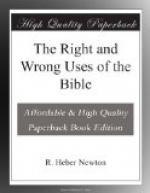These speakings of the Divine Spirit in the souls of men, at many times and in many manners, were articulated, as best was possible, in the writings of many ages and of many forms. The Bible is the collection of these writings. They require a critical study, as bona fide “letters,” before we can know the degree of their inspiration, and their place in the progressive historic revelation; before we can thus deduce aright the thoughts about God out of which we are to construct our theology. Concerning this right critical use of the Bible, I propose now to offer some practical suggestions. Next Sunday I purpose giving you a bird’s-eye view of the general course of the historic revelation which led up to the Christ, the Word of God. After which I shall pass on to consider with you the pre-eminently right use of the Bible, in which our souls humbly hearken for its words proceeding from out the mouth of God, on which man liveth; and on them feeding, grow toward a perfect manhood in Christ Jesus.
I.
Every aid of outward form should be used to make these books appear as living “letters” to us.
The traditional form in which the Bible has been given to the people would seem to have been devised with a design of robbing its writings of every natural charm, as the best means of making men feel its supernatural power. The fresh sense of “letters” disappears in this conventional form. These many books of many ages have been bound up together, with the most imperfect classification either as to period or character. A verse-making machine has been driven through them all alike, chopping them up into short, arbitrary, artificial sentences, formally numbered in the body of the text. The larger divisions into chapters have been made in an equally mechanical manner. By this twofold system an admirable provision has been made for checking the flow of the writer’s thought, and for effectually preventing any easy grasp of the natural movement of the book. Poetry has been printed as prose; thereby marring its rhythm, concealing its structure, and blinding the reader to the dramatic character of immortal works of genius. Through the whole mass of writings a system of chapter-headings has been introduced that ingeniously insinuates into the body of these sacred books, as seemingly an integral part thereof, a scheme of interpretation which possesses now no pepsine power for resolving their contents into spiritual nutriment, but rather positively hinders our assimilation of many of these books.
Probably the greatest obstacle to the use of the Bible is the senseless form in which custom persists in publishing it. I know few stronger evidences of the intrinsic power of these books than their continued influence, under conditions that would have remanded other books to the topmost shelves of the most unused alcoves in our libraries.




